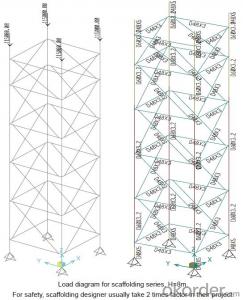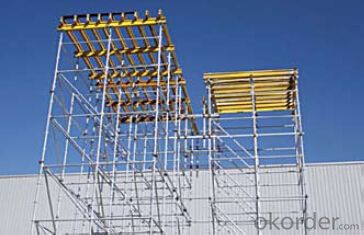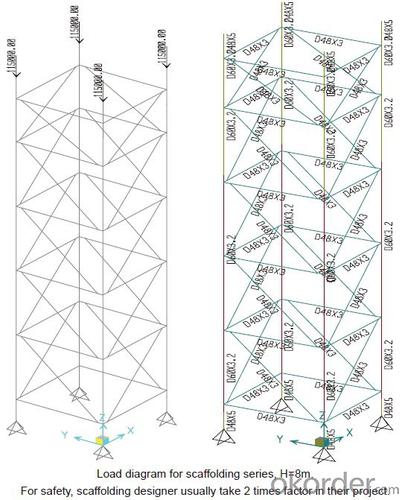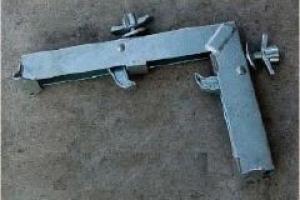Ring-lock Scaffolding Accessories for formwork and scaffolding systems
- Loading Port:
- Tianjin
- Payment Terms:
- TT OR LC
- Min Order Qty:
- 50 m²
- Supply Capability:
- 1000 m²/month
OKorder Service Pledge
Quality Product, Order Online Tracking, Timely Delivery
OKorder Financial Service
Credit Rating, Credit Services, Credit Purchasing
You Might Also Like
Ring-lock Scaffolding
A support system for construction, ownsadvantages of both cup-lock scaffolding andshoring tower.
It is in the development direction of new typescaffolding.
It is widely used in buildings, bridges, tunnels etc..
Characteristics:
◆ Easy to storage and transportation
◆ High degree of standardization
◆ Easy and quick erection
◆ Excellent stability and bearing capacity
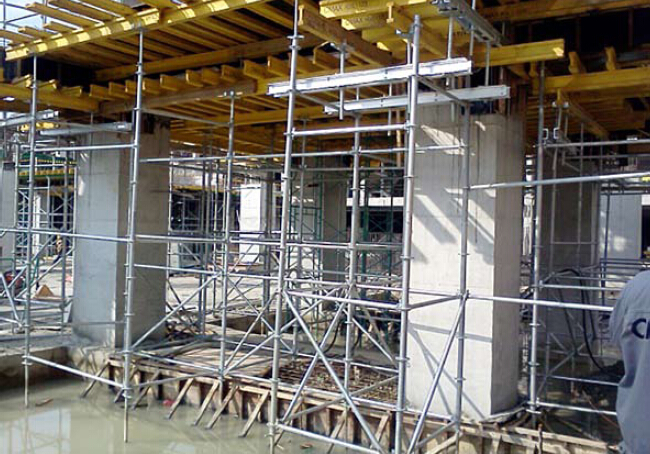
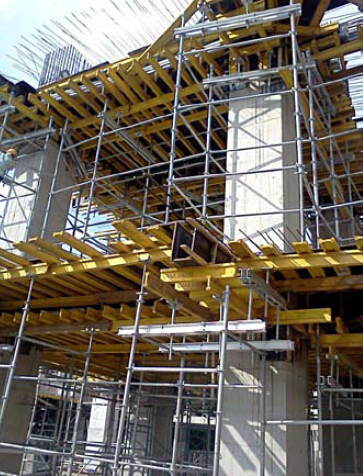
- Q: How does steel formwork handle different concrete pouring techniques?
- Steel formwork is a versatile and durable option for handling different concrete pouring techniques. Its strength and rigidity allow it to withstand the pressure exerted by various pouring methods, ensuring a stable and secure structure. One common pouring technique is the traditional gravity pouring, where concrete is poured into the formwork from the top and allowed to flow downwards due to its own weight. Steel formwork is well-suited for this method as it can easily contain the concrete and prevent any leakage or spillage. The formwork's tight joints and sturdy panels ensure that the concrete remains in place and is evenly distributed throughout the formwork. Another technique is the pumping method, where concrete is pumped into the formwork using specialized equipment. Steel formwork can handle this technique effectively as it can withstand the force and pressure exerted by the pumping process. The formwork's robust construction and reinforced edges provide the necessary support to contain the concrete and prevent any deformation or leakage. Steel formwork is also compatible with the slip-forming technique, which involves continuously pouring concrete into a moving formwork system. This method requires a formwork system that can be easily moved and adapted to changing shapes and heights. Steel formwork's modular design allows for quick and efficient adjustments, making it suitable for slip-forming applications. Additionally, its strength and stability ensure that the formwork remains intact during the continuous pouring process. In summary, steel formwork is a reliable choice for handling different concrete pouring techniques. Its strength, rigidity, and adaptability make it capable of withstanding the pressure and forces exerted by gravity pouring, pumping, and slip-forming methods. With steel formwork, builders and contractors can confidently execute various concrete pouring techniques, resulting in high-quality and structurally sound construction projects.
- Q: Are all steel plates used for beam slab prefabrication
- If all steel plates are used for precast beam and slab, the shape of prefabricated components should be adopted
- Q: Can steel formwork be used for both small-scale and large-scale projects?
- Yes, steel formwork can be used for both small-scale and large-scale projects. Steel formwork is durable, versatile, and can withstand heavy loads, making it suitable for various project sizes. Additionally, steel formwork allows for efficient construction and easy customization, making it an ideal choice for both small and large-scale construction projects.
- Q: How does steel formwork contribute to the sustainability of a construction project?
- Steel formwork contributes to the sustainability of a construction project in several ways. Firstly, steel formwork is durable and long-lasting, reducing the need for frequent replacements and minimizing waste generation. Additionally, steel is a recyclable material, meaning that at the end of its life cycle, it can be recycled and used again in other construction projects, reducing the demand for new raw materials. Furthermore, steel formwork allows for efficient and precise construction, minimizing material wastage and reducing energy consumption. Overall, the use of steel formwork promotes sustainability by minimizing waste generation, conserving resources, and enhancing construction efficiency.
- Q: Can steel formwork be used for structures with complex geometries?
- Structures with complex geometries can indeed utilize steel formwork. The versatility of steel formwork allows for easy customization to match the specific shape and dimensions of the structure. Its strength, durability, and flexibility are well-known attributes, making it suitable for constructing intricate designs and complex geometries. Steel formwork systems can be adjusted, assembled, and disassembled to create unique architectural elements and complex structural configurations. Furthermore, steel formwork guarantees a smooth and precise finish, ensuring the accuracy and quality of the final structure. In conclusion, steel formwork is a dependable and efficient choice for constructing structures with complex geometries.
- Q: What are the different types of formwork anchors used in steel formwork?
- Steel formwork commonly uses various types of formwork anchors to secure the formwork to the structure and ensure construction process stability and safety. Examples of these formwork anchors include: 1. Wedge Anchor: This anchor has a threaded rod with a wedge-shaped end. By inserting it into a pre-drilled hole in the concrete structure and tightening a nut on the threaded end, a strong grip is formed. It is commonly used to secure formwork to concrete walls or slabs. 2. Screw Anchor: Also known as self-tapping anchors, these anchors are designed for use in softer materials like wood or light-gauge steel. They have a threaded body that can be screwed into the material, providing a secure connection for the formwork. Screw anchors are popular for temporary formwork applications due to their easy installation and removal. 3. Hook Anchor: This hook-shaped anchor is typically embedded into the concrete structure during the pouring process. The formwork is then attached to the hook using bolts or fasteners, creating a strong and reliable connection. Hook anchors are commonly used in applications with high loads or lateral forces. 4. Swift Lift Anchor: Specifically designed for lifting and handling precast concrete elements, including steel formwork, these anchors are embedded into the structure during pouring. They provide a safe and efficient method for lifting and positioning the formwork. 5. Plate Anchor: Plate anchors consist of a flat plate with holes for bolts or fasteners. They are versatile and commonly used in steel formwork systems to secure the formwork to the structure. Plate anchors can be easily adjusted or relocated as needed. 6. Chemical Anchor: Chemical anchors are used when a strong and permanent connection is required. They consist of a resin or adhesive injected into a pre-drilled hole in the concrete structure. The steel formwork is then attached to the chemical anchor, creating a secure bond. Each type of formwork anchor has unique advantages and is suitable for different applications. Factors such as the type of structure, load requirements, and duration of use should be considered when selecting the appropriate anchor and ensuring proper installation for the safety and stability of the formwork system.
- Q: Is steel formwork suitable for projects with heavy concrete loads?
- Indeed, steel formwork proves to be exceptionally appropriate for projects that bear heavy concrete loads. Renowned for its strength, durability, and capacity to bear loads, steel formwork emerges as the perfect choice for endeavors entailing substantial concrete loads. Capable of enduring the pressure and weight of concrete, steel formwork ensures the preservation of its structure and integrity throughout the pouring and curing stages. Moreover, steel formwork presents superior dimensional accuracy, facilitating meticulous and consistent concrete placement, a crucial aspect for projects with heavy loads. All in all, steel formwork emerges as a dependable and robust selection for projects necessitating the support of heavy concrete loads.
- Q: Can steel formwork be used in areas with high seismic vulnerability?
- Yes, steel formwork can be used in areas with high seismic vulnerability. Steel formwork provides high strength and durability, making it suitable for withstanding seismic forces. It is a rigid system that can resist lateral loads and vibrations caused by earthquakes. Additionally, steel formwork can be easily reinforced to enhance its seismic resistance. However, it is important to ensure that proper engineering and design considerations are taken into account to ensure the formwork system is properly anchored and braced to withstand the specific seismic conditions of the area. Overall, steel formwork is a viable option for construction in high seismic vulnerability areas, but proper precautions and design adaptations must be taken to ensure its effectiveness.
- Q: How does steel formwork contribute to the overall strength of a structure?
- Steel formwork contributes to the overall strength of a structure by providing a rigid and robust framework during the construction process. It ensures accurate and precise placement of concrete, resulting in a well-supported and durable structure. The steel formwork also helps to distribute the load evenly, enhances the structural integrity, and prevents deformation or collapse under heavy loads or adverse conditions.
- Q: Can steel formwork be used in areas with high humidity?
- Yes, steel formwork can be used in areas with high humidity. Steel is a durable material that is not easily affected by moisture or humidity. It does not absorb water like wood and does not warp, swell, or rot when exposed to high humidity levels. Steel formwork also has a smooth surface that prevents the formation of mold or mildew. However, it is important to ensure proper surface protection and maintenance to prevent any corrosion due to prolonged exposure to high humidity. Regular cleaning and applying protective coatings can help extend the lifespan of steel formwork in areas with high humidity.
Send your message to us
Ring-lock Scaffolding Accessories for formwork and scaffolding systems
- Loading Port:
- Tianjin
- Payment Terms:
- TT OR LC
- Min Order Qty:
- 50 m²
- Supply Capability:
- 1000 m²/month
OKorder Service Pledge
Quality Product, Order Online Tracking, Timely Delivery
OKorder Financial Service
Credit Rating, Credit Services, Credit Purchasing
Similar products
Hot products
Hot Searches
Related keywords

